Please continue to our new site over at Fellowship Foods.
You can browse, place your orders, read our blog, and more over there.
Please continue to our new site over at Fellowship Foods.
You can browse, place your orders, read our blog, and more over there.
In continuation of my How to CSA article, I thought I’d give you an example of a menu plan based on what we’re all getting this week in our subscription boxes.
Like I mentioned, at our house we try to set a flexible plan, making a list of meals and cooking them at our convenience. We have three small children and extremely busy schedules, so our cooking reflects that.
This week the subscription box will have:
Potatoes
Apples
Sauerkraut
Collard Greens
Strawberry Jam
Lettuce
Pea Shoots
I also get eggs, butter, bread, a chicken, and a single combo meat box, so I’ll include those things too. I’ll let you know what I use from my delivery next to each meal, and as I write this I’m regretting the fact that I didn’t order cheese this time!
New Year’s Day in a Crockpot, with pan-fried potato wedges (kielbasa, sauerkraut, apples, potatoes)
Tacos (ground beef, lettuce, and salsa from our canning workshops)
Roasted Chicken Breasts with Pea Shoot, Dried Cherry, and Goat Cheese Salad (chicken, lettuce, pea shoots, bread & butter)
Tuscan Sausage & Greens Soup (italian sausage, or ground pork with sausage seasonings, potatoes, chicken broth from the above chicken, and collards subbed for kale)
Crockpot Garlic & Lime Chicken with Rice and Stir-Fried Pea Shoots (chicken, pea shoots)
Quesadillas (with leftover taco ingredients), Chips & Salsa
Little Quinoa Cakes (eggs, sub in minced pea shoots for chives) with leftover Tuscan Soup
Ham, Pierogies, and Collard Greens
Omelettes or Quiche with Leftover Ham and Pea Shoots, and Apple Dutch Baby
There’s room for the odd PB&J or pizza night in there, and very little needed from the grocery store.
What’s your plan? I’d love to hear your ideas!
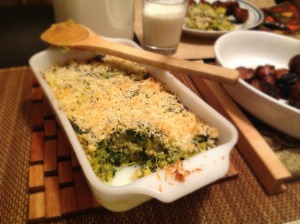
Ingredients
serves 4-6 as a side dish, 2 as a main dish
1 small/medium butternut squash or two acorn squashes
1 bunch fresh (or 10 oz frozen) kale, chopped into bite-size pieces
4 slices bacon, diced
1 clove garlic, minced
1 egg
3 tbsp butter
1/4 cup panko breadcrumbs
1/4 cup fresh-grated parmesan cheese
salt + pepper
hot pepper sauce (Frank’s, or Tabasco, etc)
Method
Preheat your oven to 350 degrees and line a cookie sheet with parchment paper. Carefully slice the squash in half, scoop out the seeds, and lay the halves cut-side down on the sheet. Roast for 35-45 minutes, or until very tender.
While the squash is roasting, bring a pot of water to a boil. Boil the chopped kale for 5-8 minutes, or until tender and still bright green. Drain well.
Cook the bacon, stirring often, and when it’s almost done, add the garlic and kale. Cook together until garlic is fragrant and bacon is crisp.
When the squash is done, scoop out the flesh and remove to a bowl. Add the egg, 2 Tbsp butter, salt, pepper, and hot sauce to taste, and half (2Tbsp) of the parmesan cheese. Mash until smooth, then add the kale mixture. Stir to combine and move to a small baking dish.
Increase the oven temperature to 400 degrees.
Melt the remaining 1Tbsp butter and combine with breadcrumbs. Sprinkle on top of the veggies and top with the rest of the parmesan. Bake for 25-35 minutes, or until the top is golden brown and casserole is hot and bubbly.
If you’re nervous about joining a CSA because you think it’ll be hard to work into your family’s budget and meal planning, never fear: it doesn’t have to be! Eating nutritious, fresh food from traceable nearby sources is good for you, your family, and your community, and it’s not necessarily a strain on your wallet.
Here are 4 basics of our family’s strategy to reduce waste and eat fresh, healthy meals:
Plan ahead after delivery day
Once I started getting most of our groceries locally, I changed my meal-planning time from the more traditional Sunday night, to Thursday night, after my subscription arrives. If you don’t change your planning strategy, you’ll be stuck with produce that you didn’t know you’d get festering in the crisper drawer while you eat the things you got at the grocery store instead. Since we get meat, chickens, eggs, dairy, bread, and produce delivered, I plan our menus around how the proteins will best complement the veggies, and my grocery store list contains pantry-stockers, a few convenience items, and ingredients to supply our baking habit. I supplement with whatever I’ve preserved earlier in the season and with stockpiled meat from the freezer to round out the menus. It’s important to me to balance the nutrition, flavor, and texture of meals, and it’s easy with a regular supply of fresh ingredients!
Eat seasonally
I’ve gotten a lot of joy in cooking and eating with the seasons both at home and professionally. Instead of eating sub-par produce from who-knows-where whenever I want, I eat what comes from here, when it’s harvested. In our four-season climate here in southwestern PA, we get a lot of agricultural variety throughout the year: the best tomatoes (really- the best), wide varieties of salad and cooking greens, squash forever and ever, prolific herbs, foraged and hunted foods, sweet grass for our dairy and beef cows, amazing apples, and, is there anything better than the first harvests of asparagus and strawberries in spring?
Granted, there are things we can’t grow here (coffee, chocolate, tea, olives, citrus, avocados, etc). For those “provencal” items that are unique to their climate, we try to source them from local or transparent sources.
Assume the budget amount
Participating in a CSA doesn’t have to throw off your budget! In fact, eating seasonally means eating cheaper, since we aren’t paying for large shipping costs behind each item. If you plan your weekly trip after your delivery arrives, you can know what you’ve already spent on your groceries, and what you’ve already got, and round out your pantry with what you need outside of the box contents. If you do your shopping trip ahead of your delivery, you’ll over- or under-buy and your budget will be off kilter.
Also, budgets are important, but no household lives in a vacuum. We all affect and are affected by our surrounding community, and our financial choices are a major part of that. If we choose to spend our hard-earned dollars within our local economic base, even if that amount is a little higher than what we’d spend at a multinational source, our investment comes back around to us in other ways, through richer products and experiences, meaningful jobs, and return investment in the community. Sometimes (but not always) the cheapest option can also be the emptiest option. Personally, I’m happy to spend a little more on products and services from hard-working local people and a little less in some other budget area (in fact, we are some of those hard-working people! Between the two of us who work Kohser Farms CSA, our households work on or at 6 different places besides home that are local and community-enriching, so we know first-hand!)
Of course, there’s always the last-minute grocery store run, or the unexpected hospitality needs, which brings me to my next and most freeing strategy…
Plan for flexibility
My life got way easier when I started making a fluid menu plan. I write down five or six meals at a time, but rarely assign them to a certain day. At least one of them can be easily doubled or just made bigger to allow for company.
Our week s are insanely busy, and running a business sometimes causes disruptions in what might otherwise have been a “normal” day. We need the freedom to switch our plans or push something off until later. To allow for flexibility, we try to keep around a couple of freezer meals ready for the oven or crockpot, and we plan on an occasional pizza or burrito fallback (and we don’t beat ourselves up about it).
s are insanely busy, and running a business sometimes causes disruptions in what might otherwise have been a “normal” day. We need the freedom to switch our plans or push something off until later. To allow for flexibility, we try to keep around a couple of freezer meals ready for the oven or crockpot, and we plan on an occasional pizza or burrito fallback (and we don’t beat ourselves up about it).
When it comes to produce, I try to plan on using up the most tender and susceptible produce first, and allow the storage items to … store.
If it looks like we won’t get to something before it goes bad, I try to preserve it quickly while I’m already in the kitchen doing other tasks (my go-to method for small amounts is freezing). If there’s something in the box I know we won’t eat, I’ll trade it with another CSA member (I’ve got a very happy beets-for-eggplant understanding with a neighbor) or give it to someone who will enjoy it.
My family has been eating local (and I’ve been sourcing local food at my cafe) since we settled here and found the sources (and I’m thrilled to work with Chip now, doing this), and I don’t see it as a complication to our family rhythm. Rather, it’s an opportunity to expand our culinary horizons, meet and understand our food sources, learn how to cook, preserve, and to reduce waste, and eat really, really good food!
Although fruit subscriptions have now ended, we still have a few weeks left of height-of-the-season veggies to enjoy fresh or preserve. I just pickled those radishes we got last week, and I’m thinking of doing a greens gratin with the beet and turnip greens (anybody have a recipe they suggest?) Apples got turned into my favorite version of apple pie EVER (that link is to an adapted version of the original from Cook’s Illustrated). What are you all doing with your goodies?
As the weather is starting to cool off a little, and the trees are just barely turning,
now’s the time to sign up for our cool-season subscription!
The winter boxes will supply us all winter long with hardy veggies and greens, storage crops, apples, eggs, bread, honey, frozen summer veggies, baked treats perfect for school lunches or snacking (like granola bars, pumpkin chocolate chip bars, apple butter oatmeal cookies, etc), prepared items like peanut butter, hummus, pickles, and jellies, and cozy drinks like homemade hot cocoa mix with (yes) homemade marshmallows, cider, and more!
And of course, these items are all locally grown, gathered, produced, and baked right here! This is a great way to experience the richness of what our region has to offer.
Our winter subscription will deliver to your desired dropoff location every other week starting November 5, and each box will be $25. And yes, you can sign up now, even if you’re new to Kohser Farms!
Our meat, poultry, and other subscriptions are still available, but will deliver every other week instead of weekly. At each delivery, you’ll get as much as you would have gotten over two weeks in the summer.
Also, keep an eye out for our events and specials, like monthly homemade soup sales, meal kits, seasonal decor, Thanksgiving turkeys and pumpkin pies, and our 1/2 steer sale. We’ll announce them via email, social media, word of mouth, carrier pigeon, and whatever else people are doing these days to communicate.
We’re loving the cooler weather- how about you?
You can order locally produced fall decor and apple cider right here!
We’ll be delivering these to our usual dropoffs around the region through the week of 10/26/14. Order by Sunday the week you’d like yours to arrive.
If you’re a new customer, email ckohser@verizon.net to set up your delivery!







Have you always wanted to learn how to can? Interested in expanding your repertoire of canning and preserving recipes? Don’t have the time?
We are excited to announce our five-part food preservation series!
All manner of greens and lettuces have been showing up in our subscription boxes recently. Here’s how we like to store them to extend their life and keep them crisp:
First, fill up your sink or a clean basin with enough water so that when your greens go in, they don’t touch the bottom. Add a little white vinegar (this does wonders for any greens have already been sitting a couple days). Remove the root from your greens (I just hack it off with a sharp knife) and submerge in the water. Swish them around gently, then just leave them for a few minutes. The dirt will sink to the bottom while the lettuce stays in top.
If you have a salad spinner, use it to remove as much water as you can, then roll the greens up gently, in a single layer, in paper towels or a very clean tea towel.

Put that roll into a ziploc bag, but don’t zip it. Stash that in your fridge, and enjoy as you like. We just ate tender salad greens we had stashed that way a week and a half ago and they still crunched! This works very well with any greens- kale, chard, romaine, mesclun, spinach, etc.
Here’s one of my favorite summer salad recipes:
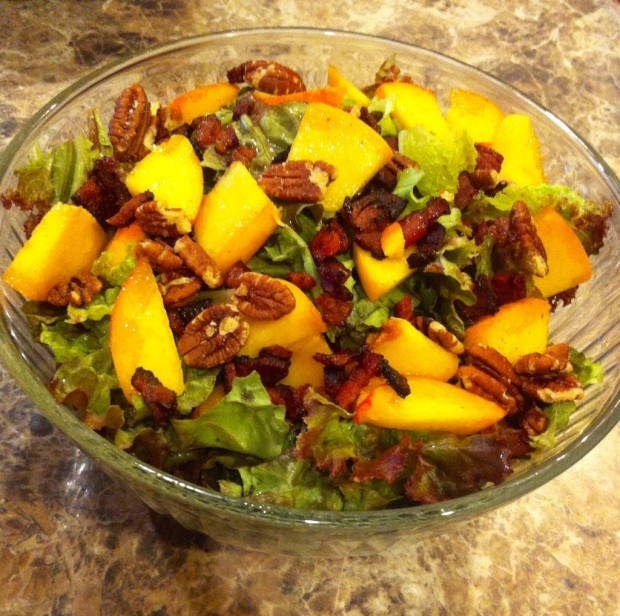
Southern Peach Salad
Salad greens
Diced, cooked bacon
Diced peaches
Candied pecans
Peanut Butter Vinaigrette
1 Tbsp peanut butter
1/4 cup apple cider vinegar
1 tsp Olive oil
1/2 tsp sugar
Salt and pepper to taste
Whisk dressing ingredients together, drizzle to serve over tossed salad
We’ve got a new item, and this week our customers get one to try, free!
Perfect for French toast, this bread uses wholesome ingredients, free range eggs, and no chemical preservatives.
Here’s what 5 Generation Bakers has to say about their Cinnamon Swirl Bread:
In 2010, Scott Baker reincarnated his family’s 150 year old baking tradition and founded 5 Generation Bakers to meet ongoing demand for their cornerstone product; Jenny Lee® Gourmet Cinnamon Swirl Breads. Unlike common raisin breads or cinnamon breads—nothing more than over-emulsified white bread with a cinnamon dusting and/or a few raisins incorporated into it—Jenny Lee Gourmet Cinnamon Swirl Breads start out with the flavor and texture of a sweet dough, rich in sugar and eggs. The dough is gently sheeted out, fine Korintje cinnamon is then dusted atop, it is rolled into a “snake,” then gently cut into carefully sized loaves with a cinnamon swirl from end-to-end. Placed into cylindrical, two-piece “crimp pans,” it is slowly proofed to just the right size, then baked to the perfect color and texture. Then, after partial cooling, the loaves are bathed in a melted butter bath, to which a coating of rich cinnamon-sugar adheres. The result, as anyone who has tried it will tell you, is a product which—whether toasted and buttered or used as a basis for French toast or breakfast sandwiches—is undeniably tasty and wholesome.”
Order more for $3.50/loaf.
This is a teaser for our upcoming food preservation workshop series, which we’ll announce in the coming weeks
The worst part about berry season is the day it’s over. I’m always trying to prolong my access to berries in any way to avoid the inevitable sadness that occurs when my raspberries stop producing, and the blueberries start looking overripe and mushy.
My favorite way to keep it going: freezing!
Berries are particularly well-suited, if treated properly, to hang out in the freezer, conveniently waiting for your craving to hit.
Here’s the method:
We’re going for individually frozen, loose pieces, for convenience and flavor. If your berries are frozen in a wet clump, it forces you to defrost and quickly use a preset amount at once, which may not be convenient at the time. I find it unnecessary to coat them in a sugar syrup before preserving. But it is delicious and attractive to make a quick vanilla syrup to coat the berries in just before baking exposed on a pastry or topping a waffle!
Obtain berries as fresh as possible, through our CSA here (look for preserving quantities available to special order soon), the farmers’ market, or your own garden.
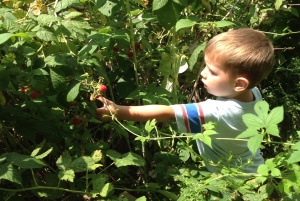
Pick over, rinse, and dry very thoroughly (that’s important to avoid non-tasty ice crystallization).
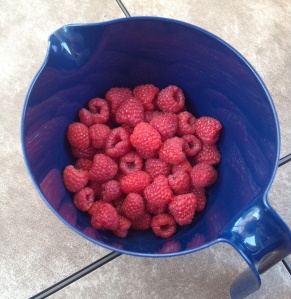
Gently arrange in a single layer on a clean, dry, metal cookie sheet, and stash in your freezer. Don’t crowd the pan- the idea here is to freeze individual berries, not masses of smooshed berries (I mean, those taste good too, but it’s not ideal).
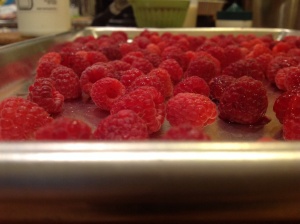
Stainless steel and aluminum are great conductors of heat, so if you stick them in the freezer, they will transfer that temperature to your berries much more quickly than plastic would, resulting in smaller ice crystals and therefore better texture and flavor.

As soon as they’re frozen, transfer to a labelled ziploc bag.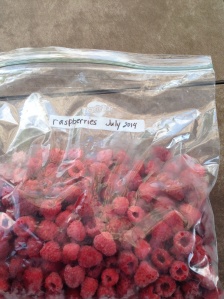
Now, you can pull out handfuls as you need for your yogurt in the morning, a refreshing snack for your kids on a hot day, smoothies, pancake mixins, pie-baking, or sweet relief for teething babies (I like to stick the frozen berries in one of those netted pacifier things that help babies learn to self feed).
What do you like to do with frozen berries?